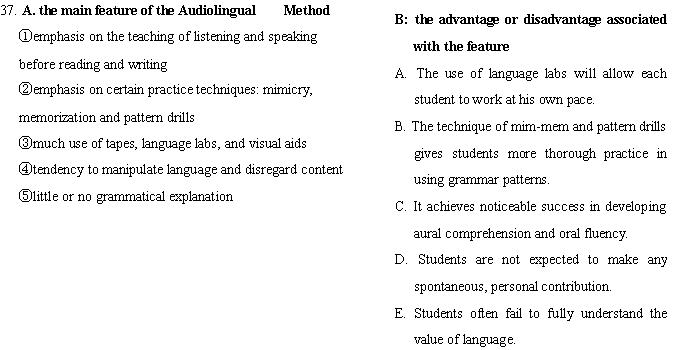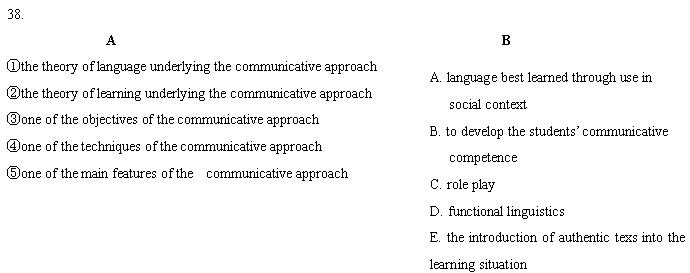
《自考视频课程》名师讲解,轻松易懂,助您轻松上岸!低至199元/科!
全国2007年10月高等教育自学考试
外语教学法试题
课程代码:00833
I. Multiple Choice: (15%)
Directions: In this section, you are given 15 questions beneath, each of which has four choices marked A, B, C, and D. You are to make the best choice either to complete the incomplete statement or to answer the question. One point is given to each correct choice.
1. Traditional linguists believed that the written form of language was ______ the spoken form.
A. the same as
B. inferior to
C. superior to
D. different from
2. According to M.A.K. Halliday, which of the following should NOT be taken into consideration in terms of linguistic events?
A. Form.
B. Context.
C. Substance.
D. Culture.
3. The learning theory which served as the basis of the Grammar-Translation Method was ______ Psychology.
A. Development
B. Faculty
C. Child
D. Social
4. In the Direct Method, ______ is learned inductively through listening and speaking activities.
A. grammar
B. vocabulary
C. writing
D. sentence
5. When was the Direct Method developed as a reaction against the Grammar-Translation Method?
A. In the late 19th century.
B. In the early 20th century.
C. In the mid-19th century.
D. In the early 19th century.
6. The Advanced Learner’s Dictionary of Current English, one of the greatest contributions by Hornby to EFL teaching, was published in ______.
A. 1983
B. 1973
C. 1963
D. 1953
7. Which of the following is NOT one of the systematic principles the Oral Approach involves?
A. Selection.
B. Introduction.
C. Gradation.
D. Presentation.
8. The theoretical linguistic background of the Audiolingual Method is ______.
A. Latin grammar
B. Audiolingualism
C. Structuralism
D. generative-transformational grammar
9. The Audiolingual Method insists on accurate reproduction of sentence patterns and its attitude towards students’ language ______ is negative.
A. responses
B. performance
C. reproduction
D. errors
10. According to D. Ausubel, the principal function of ______ is to act as a bridge between what learners already know and what they need to know.
A. schema theory
B. language acquisition device
C. language competence
D. advance organizers
11. A major feature of cognitive code-learning is the emphasis on explanations of ______.
A. grammatical functioning
B. conscious selection of words
C. deductive order of learning
D. language instruction
12. In Krashen’s view, acquisition refers to the ______ process leading to the development of competence and is not dependent on the teaching of grammatical rules.
A. conscious
B. unconscious
C. overconscious
D. subconscious
13. Children develop language competence in their first language in a relatively short time merely by ______ it.
A. being exposed to
B. speaking
C. using
D. listening to
14. Who first used the term "communicative competence" in deliberate contrast to Chomsky’s "linguistic competence"?
A. Stern
B. Asher
C. Krashen
D. Hymes
15. What Hao Youming proposes in her ______ Method is "more practice, less examination".
A. ASSRF
B. Leveled
C. Global
D. Dual Activity
II. Filling Blanks: (20%)
Directions: In this section there are 20 statements with 20 blanks. You are to fill each blank with ONE appropriate word. One point is given to each blank.
16. Behaviorism believes that basic learning processes could be described in terms of ______ and responses.
17. Second language acquisition, as a complex cognitive skill, involves the processes of ______ and restructuring.
18. We find it hard to present a full picture of the historical development of foreign language teaching because of scarcity of ______.
19. The Grammar-Translation Method belonged to the school of ______ linguistics.
20. F. Gouin’s linguistic and psychological theories based on his observations of children’s use of language were directly applied to the practice of the ______ Method.
21. The teacher uses the ______ language of the students as the main medium in teaching in a Grammar-Translation classroom.
22. The reason for the exclusive use of the foreign language in the Direct Method is to enable the students to think in the target language, so that they can use it to express themselves ______ without referring to their mother tongue.
23. Books such as A Grammar of Spoken English on a Strictly Phonetic Basis, A Handbook of English Grammar, Guide to Patterns and Usage in English served as a standard ______ source of basic English sentence patterns for textbook writers.
24. Like other approaches of foreign language teaching, the objectives of the Oral Approach are to help learners get a practical ______ of the four basic skills of language.
25. The learning theory of the Audiolingual Method is ______ in psychology.
26. In an Audiolingual Method classroom, listening is viewed as training in ______ discrimination of basic sound patterns.
27. Chomsky rejected the behaviorist model of language acquisition on the basis of his model of competence and ______.
28. The Cognitive Approach holds that students’ mistakes are ______ in the creative use of language.
29. The ______ i+1, put forward by Krashen, means input that contains structures slightly above the learner’s present level.
30. The Natural Approach suggests that grammar use should be limited to situations where it will not ______ with communication.
31. The educational perspectives in the Communicative Approach evolved alongside the significant developments in linguistics, ______ and psychology.
32. According to Canale and Swain, communicative competence includes four dimensions: grammatical, discourse, sociolinguistic and ______ competence.
33. The Silent Way is based on the principle that successful learning involves commitment of the self to language acquisition through the use of silent ______ and then active trial.
34. Since the end of World War II, teachers have found themselves under considerable pressure to abandon the long-standing ______ model, though it had been in general use in second language teaching since the late 18th century.
35. The goals of language instruction in the 1960s were on the oral medium, and ______ was deemphasized.
III. Matching: (15%)
Directions: This section consists of three groups of pairs listed in two columns, A and B. You are to match the one marked ①, ②, ③, ④, or ⑤ in Column A with the one marked A, B, C, D, or E in Column B. One point is given to each pair you match correctly.


IV. Questions for Brief Answers: (30%)
Directions: This section has six questions. You are to briefly answer them. Five points are given to each question.
39. What is the major objective of learning a foreign language in a Grammar-Translation classroom?
40. What is the learning theory of the Direct Method as summarized by Comenius?
41. What else is the Oral Approach referred to as?
42. What are the procedures followed in a Cognitive Approach classroom?
43. What is Krashen’s definition of acquisition?
44. What language ability does Hyme’s "communicative competence" refer to?
V. Questions for Long Answers: (20%)
Directions: The two questions in this section are to be answered on the basis of your own teaching experience as well as the theoretical knowledge you’ve learned. Ten points are given to each question.
45. What is the importance in taking the course "Foreign Language Teaching Methodology "?
46. What do you think the three methods (the Silent Way, Community Language Learning, and Suggestopaedia) have in common?
本文标签:广州自考 历年真题 全国2007年10月高等教育自学考试外语教学法试题
转载请注明:文章转载自(http://www.guangzhouzikao.com)
以上是广州自考网(www.guangzhouzikao.com)整理的“全国2007年10月高等教育自学考试外语教学法试题”相关资讯,如果您还想了解更多广州自考网、广州自考报名和广州自考本科的资讯,请浏览本站其它文章。

《广州自考网》免责声明:
1、由于考试政策等各方面情况的调整与变化,本网提供的考试信息仅供参考,最终考试信息请以省考试院及院校官方发布的信息为准。
2、本站内容部分信息均来源网络收集整理或来源出处标注为其它媒体的稿件转载,免费转载出于非商业性学习目的,版权归原作者所有,如有内容与版权问题等请与本站联系。联系邮箱:812379481@qq.com